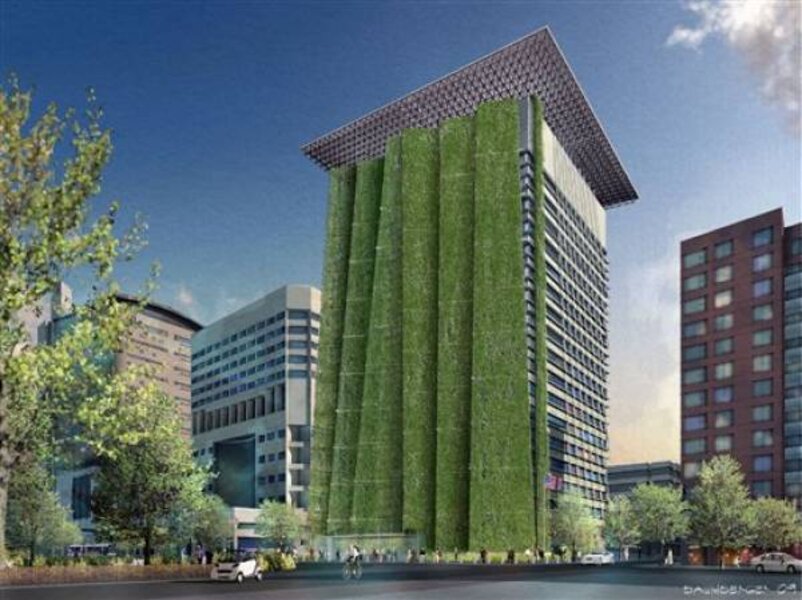New green wonder: the Hanging Gardens of ... Portland?
Loading...
| PORTLAND, Ore.
They haven't figured out yet how to get the pruning done, but architects and federal officials plan one of the world's most extensive vertical gardens in downtown Portland — what amounts to a series of 250-foot--tall trellises designed to shade the west side of an 18-story office building.
It is not a new idea to use greenery vertically as "living architecture," running plants up the sides of a building to keep it cool. But even in a city with a reputation for rain-fed greenery as well as for green architecture, the wall of the Edith Green-Wendell Wyatt Federal Building would stand out.
The architects' plans call for seven vertical "vegetated fins" to jut at acute angles. The fins would be the metal framework for planters and the greenery sprouting from them.
The west wall is 150 feet long, making the expanse to be shaded about three-quarters the size of a football field, minus the end zones.
The work is part of a $135 million remodeling, with most of the money from federal stimulus funds. It is the largest single stimulus project announced so far in Oregon. The US General Services Administration (GSA) says its goal is to create a "landmark high-performance building."
The green wall concept is familiar to anyone who has planted a deciduous tree or used a vine-covered trellis on the west side of the house: In the summer the leaves provide cooling shade; in the winter, the bare limbs and stems admit comforting light.
"If you think about it, it's a planter every 25 feet," architect Don Eggleston says. "A lot of people have 10-foot trellises in their gardens."
Mr. Eggleston's firm, SERA Architects, is working on some questions that weekend gardeners never have to figure out: what plants will grow readily at more than 200 feet in the air and how to water, fertilize, weed, and prune at that height.
The pruning might be done in much the same way windows are washed, he says, with workers hoisted and lowered on platforms.
Rainwater collected on the roof, supplemented by city water, will be piped for irrigating the green wall, he says.
The building is a modernist, International style high-rise completed in 1975 and named for two US. representatives from northwest Oregon. Across a city park, it is face to face with City Hall.
It hasn't gotten a great deal of respect in Portland. Bart King, author of a local guidebook to the city's architecture, says he found it ugly and boring, so he didn't include it.
It hasn't aged well, either. Its precast concrete facade has settled, opening gaps around its single-pane windows, and it's leaking air and water, says Kevin Kampschroer, the GSA official in charge of the greening of the federal buildings.
"It's not structurally unsound, but it's not going to get any better," says Mr. Kampschroer.
So, off will come the facade, and out will come some of the building's guts.
Construction is expected to take 30 to 40 months. Federal workers are beginning to move to temporary quarters.
The GSA, landlord for federal office buildings, lists other energy-efficient features: Elevators that generate electricity on the way down, solar arrays on the roof, smart lighting systems that adjust to the daylight available, using some of the collected rainwater to flush toilets.
The building's three other walls will have less striking treatments: shades on the south and east walls and windows that drink in the indirect north light.
The building's roof will stick out — about 20 feet — and look like a giant mortarboard. The overhang is designed for shade.
But attention is likely to turn quickly to the plans for a greened-up west wall.
Sean Hogan – a writer, nursery owner, and garden designer who worked on a green wall several years ago for the parking garage at Portland's airport – says irrigation and plant selection will be critical to keeping a green wall green in Portland's summers.
Despite its national reputation as a drizzly place, the city's climate is Mediterranean, with warm to hot temperatures from late spring to early fall and little rainfall. Garden irrigation is commonplace.
"Trust me, it will be a challenge," says Randy Gragg, former architecture critic for The Oregonian newspaper and editor of Portland Monthly magazine. "It will get baked, absolutely."
The idea of vertical gardens has a root in antiquity — the Hanging Gardens of Babylon, probably near Baghdad, were in legend one of the seven wonders of the ancient world. Their existence and extent, however, are in question.
More recently, green roofs have become established as a way of providing insulation and controlling stormwater runoff, among other benefits, and green walls have begun to emerge as not only pleasing to the eye but also part of highly efficient buildings.
At small scale, green walls can even provide fruits and vegetables, but they are used mostly for energy and environmental benefits: insulation, cleansing urban air, deadening sound, sequestering carbon.
The president of a trade group that promotes green roofs and walls says the Green-Wyatt installation is likely to be the most extensive in North America so far.
"The GSA has been a real leader in the use of green roofs and walls," says Steven Peck of Green Roofs for Healthy Cities. "It's nice to see the government leading by example."
Editor’s note: For more on gardening, see the Monitor’s main gardening page, which offers articles on many gardening topics. Also, check out our blog archive and our RSS feed. You may want to visit Gardening With the Monitor on Flickr. Take part in the discussions and get answers to your gardening questions. If you join the group (it’s free), you can upload your garden photos and enter our contests.





